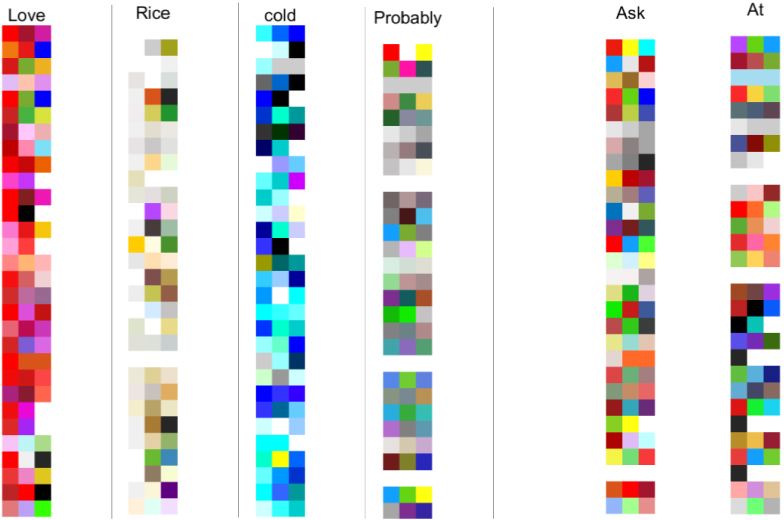References
1GageJ.Colour and Meaning: Art, Science and Symbolism1999Thames and HudsonLondon
2KressG.Van LeeuwenT.2002Colour as a semiotic mode: Notes for a grammar of colourVis. Commun.1343368343–6810.1177/147035720200100306
3
4GrieveK. W.1991Traditional beliefs and colour perceptionPerceptual and Motor Skills72131913231319–2310.2466/pms.1991.72.3c.1319
5XinJ. H.ChengK. M.ChongT. F.SatoT.NakamuraT.KajiwaraK.HoshinoH.1998Quantifying colour emotion-what has been achievedRes. J. Textile and Apparel2465446–5410.1108/RJTA-02-01-1998-B005
6OuL.LuoM. R.WoodcockA.WrightA.2004cA study of colour emotion and colour preference. III. Colour preference modellingColor Res. Appl.29381389381–910.1002/col.20047
7OuL.LuoM. R.WoodcockA.WrightA.2004bA study of colour emotion and colour preference. II. Colour emotions for two-colour combinationsColor Res. Appl.29292298292–810.1002/col.20024
8OuL.LuoM. R.WoodcockA.WrightA.2004aA study of colour emotion and colour preference. I. Colour emotions for single coloursColor Res. Appl.29232240232–4010.1002/col.20010
9Kauppinen-RäisänenH.LuomalaH. T.2010Exploring consumers’ product-specific colour meaningsQualitative Market Research: An International Journal13287308287–30810.1108/13522751011053644
10WonS.WestlandS.2017Colour meaning in contextColor Res. Appl.42450459450–910.1002/col.22095
11DorcusR. M.1926Color preferences and color associationsPedagogical Seminary and J. Genetic Psychol.33399434399–43410.1080/08856559.1926.10532367
12
13GoetheJ. W. V.EastlakeC. L.Theory of Colours2006DoverMineola, NY
14KayaN.EppsH. H.2004Relationship between color and emotion: A study of college studentsCollege Student J.38396406396–406
15JonauskaiteD.Abu-AkelA.DaelN.OberfeldD.Abdel-KhalekA. M.Al RasheedA. S.AntoniettiJ.-P.BogushevskayaV.ChamseddineA.ChkoniaE.CoronaV.Fonseca-PedreroE.GriberY. A.GrimshawG.HasanA. A.HavelkaJ.HirnsteinM.KarlssonB. S. A.LaurentE.MohrC.2020Universal patterns in color-emotion associations are further shaped by linguistic and geographic proximityPsychol. Sci.31124512601245–6010.1177/0956797620948810
16WierzbickaA.The meaning of colour terms and the universals of seeingSemantics: Primes and Universals1996287334287–334
17CaivanoJ. L.1998Color and semiotics: A two-way streetColor Res. Appl.23390401390–40110.1002/(SICI)1520-6378(199812)23:6<390::AID-COL7>3.0.CO;2-#
18HanadaM.2018Correspondence analysis of color–emotion associationsColor Res. Appl.43224237224–3710.1002/col.22171
19FugateJ. M. B.FrancoC. L.2019What color is your anger? Assessing color-emotion pairings in English speakersFrontiers in Psychology1171–1710.3389/fpsyg.2019.00206
20ShiraiM.SoshiT.2023Color features continuously represent negative and positive aspects of sadnessJ. Gen. Psychol.1509611996–11910.1080/00221309.2021.1922344
21AresG.DelizaR.2010Studying the influence of package shape and colour on consumer expectations of milk desserts using word association and conjoint analysisFood Quality and Preference21930937930–710.1016/j.foodqual.2010.03.006
22ChenY.YuL.WestlandS.CheungV.2021Investigation of designers’ colour selection processColor Res. Appl.46557565557–6510.1002/col.22631
23HsiaoS.-W.1995aA systematic method for color planning in product designColor Res. Appl.20191205191–20510.1002/col.5080200309
24HsiaoS.-W.1995bA systematic method for color planning in product designColor Res. Appl.20191205191–20510.1002/col.5080200309
25SmithG.WhitfieldT. W. A.2005Profiling the designer: A cognitive perspectiveThe Design Journal83143–1410.2752/146069205789331646
26WonS.WestlandS.2018Requirements capture for colour information for design professionalsColor Res. Appl.43387395387–9510.1002/col.22198
27ChenY.YangJ.PanQ.VazirianM.WestlandS.2020A method for exploring word-colour associationsColor Res. Appl.45859485–9410.1002/col.22434
28OsgoodC. E.SuciG. J.TannenbaumP. H.The Measurement of Meaning1957University of Illinois PressUrbana
29VolkovaS.DolanW. B.WilsonT.CLex: A lexicon for exploring color, concept and emotion associations in languageProc. 13th Conf. European Chapter of the Association for Computational Linguistics2012Vol. 9Association for Computational Linguistics306314306–14
30RenoufA.SinclairJ.1991Collocational frameworks in englishEnglish Corpus Linguistics128143128–43
31SelkirkE.McCarthyJ. J.The Prosodic Structure of Function WordsOptimality Theory in Phonology2004Blackwell Publishing Ltd.Oxford, UK10.1002/9780470756171.ch25
32GenettiC.How Languages Work: An Introduction to Language and Linguistics2018Cambridge University PressCambridge, UK
33WestlandS.RipamontiC.CheungV.Computational Colour Science Using MATLAB2012John Wiley & SonsHoboken, NJ
34RenS.ChenY.WestlandS.YuL.2021A comparative evaluation of similarity measurement algorithms within a colour paletteColor Res. Appl.46332340332–4010.1002/col.22591
35HuntR. W. G.PointerM. R.Measuring Colour2011John Wiley & SonsHoboken, NJ
36BenestyJ.ChenJ.HuangY.CohenI.Pearson correlation coefficientIn Noise Reduction in Speech Processing2009SpringerCham141–410.1007/978-3-642-00296-0_5
37
38
39

 Find this author on Google Scholar
Find this author on Google Scholar Find this author on PubMed
Find this author on PubMed
 Open access
Open access